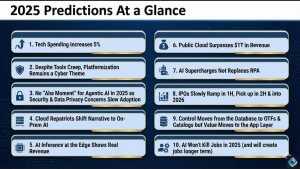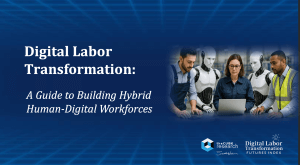Executive Summary
Scott Mullins’ tenth-anniversary keynote at the AWS Financial Services Symposium, marks an important inflection point for both Amazon Web Services and the global financial-services (FS) community it serves. By framing the conversation around Arthur C. Clarke’s laws of technology, Mullins positioned AWS not merely as the industry’s preferred cloud utility, but as the launch pad for a coming wave of agentic AI systems that promise to attack latency—both technical and operational—across capital markets, retail banking, insurance, and fintech. The message was clear, core cloud infrastructure (e.g. compute, storage, networking) is table stakes; the contest now centers on who can orchestrate multi-agent workflows, at scale, under bank-grade governance.
Key Takeaways
| Focus | What the Data Suggests | Why It Matters |
|---|---|---|
| Scope and Scale | Scale advantage widens. AWS now operates 136 Availability Zones across 43 regions (Chile the latest) plus hundreds of edge locations (see below). | Latency-sensitive FS workloads—low-touch trading, real-time risk, instant payments—shift toward the provider with the densest, most proximate infrastructure. |
| The Agentic Future | Agents are becoming mission-critical. Logos on Slide below—ADP, Moody’s, Robinhood, Bridgewater, HSBC Life—confirm that production agentic pilots have moved beyond POCs to value capture for a select group of firms. | Early adopters report double-digit productivity gains in underwriting, code conversion, and customer engagement. Competitive parity will require similar adoption curves across Tier-1 banks in 2025-26. |
| Customer Choice & Control | Bedrock is AWS’s control plane for AI systems. The “fully-managed and DIY” narrative (Slide below) underscores a dual strategy: provide opinionated guard-rails while still courting open-source enthusiasts. | Banks can mix-and-match proprietary LLMs and specialized SLMs with open models inside a single, governed runtime—critical for data-sovereignty and model-risk-management mandates. |
| Specialization | Specialized agents target line-of-business pain points. Amazon Q Developer, Q Business, and Q QuickSight move beyond generic chat to domain-specific copilots. | We expect Q SKUs to land squarely against Microsoft Copilot’s product family—setting up a share-of-wallet battle in 2025 renewals. |
| Foundational Services | Foundational services still drive the bill. Mullins reminded the audience that GenAI remains “anything but basic;” every agent sits atop S3, DynamoDB, SageMaker, and EC2 (Trainium & Inferentia). | In our view, AWS is signaling that the AI gold rush will ultimately monetize through storage I/O, distributed databases, and GPU-class compute—areas where it retains operating margin leadership. |
| Customer Obsession | Customer evidence is maturing. S&P Global closed 17 data centers, Coinbase slashed developer onboarding to six weeks, and Northwestern Mutual built a multi-agent evaluator to enforce PII guard-rails. | These case studies show that the conversation has moved from “Can we?” to “How fast can we?”, shrinking AI project timelines from quarters to weeks. Again these are bleeding edge customers in our view, ahead of the “fat middle.” |
| Cultural Energy | Cultural narrative resonates. The “Blaze / Break / Push” motif and Blue Angels anecdote reinforce AWS’s execution ethos—precision, proximity, iteration. | FS executives told us privately that AWS’s culture-of-execution message remains a decisive factor in vendor selection, even as feature parity tightens across hyperscalers. |
From 35 Financial Services Pros to a Standing-Room-Only Crowd
A decade ago, 35 attendees squeezed into the Roosevelt Hotel to debate cloud viability for regulated workloads. Today, several hundred practitioners (500-700 by our estimates) filled the Tribeca event space . Our research indicates that AWS’s FS revenue has compounded at ~40 % CAGR since that first symposium, outpacing its overall enterprise mix and validating Mullins’ bet that capital-market sophistication would ultimately demand hyperscale elasticity, ecosystem depth/breadth and innovation.
Infrastructure Follows the Data
AWS’ world map shown below, underscores AWS’s focus on regional proximity as a key component of its service delivery. With 40+ regions and metro-edge expansions in progress—including Local Zones near major trading venues—AWS is effectively underwriting sub-5 ms round trips between colo, exchange matching engines, and its own fabric. In our opinion, while rivals rush to replicate this capability, and often claim more data center locations, AWS’ focus on cloud resilience, security and availability is impressive.

Agents Are the New APIs
Mullins’ plotted a maturity curve that we would summarize as moving from rule-based assistants → goal-based agents → fully autonomous agentic systems. We believe this framing matters because it shifts the KPI discussion from prompt-accuracy metrics to workflow-completion rates and economic value. Mullins mapped specific FS use cases such as from code conversion to real-time underwriting, illustrating how agentic logic can permeate front-, middle-, and back-office functions.
Mullin’s cited several customer proof points pursuing agentic as shown below.

Bedrock, Q, and Guard-Rails
AWS’s answer to model fragmentation is Bedrock’s mix-match-and-govern architecture. Customers choose from proprietary (Anthropic, Cohere, Meta, Nova) or private models, then layer Bedrock Agents and Bedrock Flows for orchestrating multi-step tasks. Crucially, Northwestern Mutual’s agent evaluator pattern shows how FIs can insert policy controls directly into the reasoning loop. We believe this is increasingly an emerging best practice that regulators will endorse.

In parallel, Amazon Q packages domain-specific prompts, retrieval pipelines, and fine-tuned checkpoints for developers, BI users, and knowledge workers. Our premise is tht Q will drive incremental adoption and customer expansion adding perhaps 4-6 percentage points of growth AWS FS next year.
Customer Proof Points: Blaze, Break, Push
The on-stage trio of S&P Global, Coinbase and Nasdaq mapped to Mullins’ three themes:
- Blaze new trails (S&P Global). By shuttering 17 data centers and migrating thousands of workloads, S&P cut change-cycle time from quarters to weekly sprints. The next objective: agentic data products on demand for buy-side clients.
- Break barriers (Coinbase). Six-week Dev cycles on Bedrock reduced smart-contract audit latency, a critical advantage in volatile crypto markets.
- Push beyond (Nasdaq). Real-time market-tech services—powered by Bedrock flows and Trainium clusters—aim to compress settlement risk and create new monetization tiers for market participants.

Our assessment is these examples validate AWS’s claim that agentic architectures are no longer experimental for the leading edge companies. Rather they can underpin revenue producing services at Tier-1 scale. Notably, these examples are not representative of the broader market, but they are indicative of the potential customers can achieve.
Competitive Lens
Microsoft Azure continues to tout its 16-point AI growth kicker and tight M365 integration, while Google Cloud leverages Gemini’s n-shot reasoning and Vertex’s RLHF pipelines. Yet AWS’s pitch resonates on three dimensions:
- Latency economics for trade-time workflows.
- Model plurality under a single policy plane.
- Custom silicon (e.g. Trainium v2) with price/performance advantages for large-context agents.
We believe those factors will keep AWS as a primary choice for FS firms where milliseconds and model-risk governance trump office-suite adjacency.
What to Watch
- Regulatory clarity around agentic AI – compliance, audit trails and security robustness.
- Bedrock multi-agent collaboration GA timelines and early reference architectures.
- Trainium/Inferentia uptake vs. NVIDIA Blackwell in risk-oriented workloads.
- Cross-cloud data-plane moves—will AWS embrace Snowflake-style federated query to retain data gravity?
- Data fragmentation – without clean data, agentic value will be constricted. AWS is making major moves in simplifying its bespoke data experience for customers, which we believe is critical for agentic success.
- Data gravity and the degree to which organizations see “bringing AI to the data” versus migrating to the cloud for mission critical workloads. We’re watching how AWS plays that dynamic with Outposts or local zones.
Closing Thoughts
In our view, Scott Mullins has recast AWS’s FS narrative from cloud modernization to agentic transformation. The keynote’s themes of blaze, break, push—signals that the next competitive frontier will be won by institutions that compress workflow latency with autonomous, policy- and process-aware agents running on proximate infrastructure. If the Blue Angels can tighten formation gaps to 18 inches, Wall Street technologists can surely close the distance between idea and execution. AWS intends to supply the jet fuel to do so.



